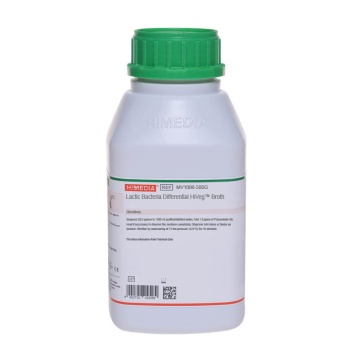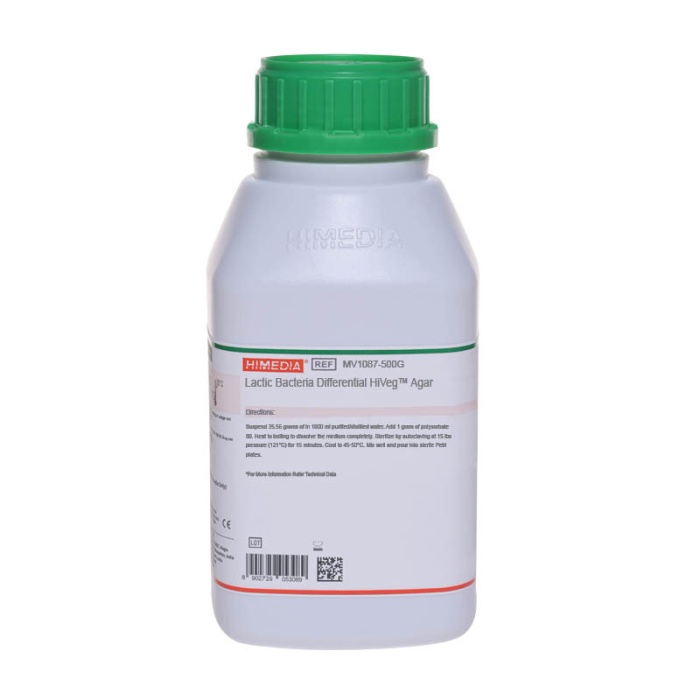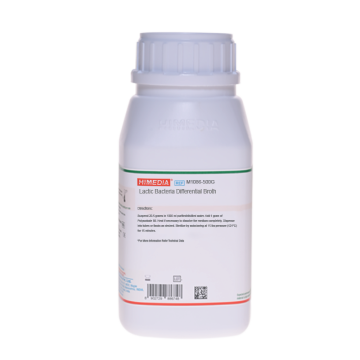 Your enquiry has been submitted
Your enquiry has been submitted
Lactic Bacteria Differential Agar
Lactobacilli / Yeasts#CC293D
Intended Use
Recommended for differentiation of homofermentative and heterofermentative lactic acid bacteria.
Composition**
| Ingredients | Gms / Litre |
|---|---|
| Tryptone | 10.000 |
| Soya peptone | 1.500 |
| Acicase™ # | 3.000 |
| Yeast extract | 1.000 |
| Fructose | 2.500 |
| Potassium dihydrogen phosphate | 2.500 |
| Bromocresol green | 0.055 |
| Agar | 15.000 |
Final pH (at 25°C): 7.0±0.2
**Formula adjusted, standardized to suit performance parameters # Equivalent to Casein acid hydrolysate
Directions
Suspend 35.56 grams in 1000 ml purified/distilled water. Add 1 gram of polysorbate 80. Heat to boiling to dissolve the medium completely. Sterilize by autoclaving at 15 lbs pressure (121°C) for 15 minutes. Cool to 45-50°C. Mix well and pour into sterile Petri plates.
Principle And Interpretation
Lactic Bacteria Differential Agar is formulated as per McDonald et al (4) for differentiation of homofermentative lactobacilli and heterofermentative streptococci. Lactobacilli and Streptococci are used as starter cultures in food and dairy industry. Streptococci grow first and produce metabolites, lowering the redox potential which enables Lactobacilli to grow. Lactobacilli synthesize products, which stimulate growth of Streptococci.
Medium constituents like Acicase™, soya peptone and yeast extract supplies nitrogen and carbon compounds, long chain amino acids, vitamins and all the necessary nutrients for the growth of lactic bacteria. Fructose is the fermentable carbohydrate in the medium. Bromo cresol green is the pH indicator.
Heterofermentative lactic acid bacteria produce CO2, lactic acid, acetic acid, ethanol and mannitol. Homofermentative lactic acid bacteria produce only lactic acid. Homofermentative lactic acid bacteria produce lactic acid from fructose and is indicated by yellow colour formation. Heterofermentative lactic acid bacteria induce lesser acidification and thus vary in the colour formation by the indicator in the medium. Homofermentative bacteria cultivated on this medium form bluish-green colony on agar while heterofermentative bacteria do not form much-coloured colony on agar surface.
Type of specimen
Isolated Microorganism from food and dairy samples
Specimen Collection and Handling
For food and dairy samples follow appropriate techniques for handling specimens as per established guidelines (1,5,6). After use, contaminated materials must be sterilized by autoclaving before discarding.
Warning and Precautions
Read the label before opening the container. Wear protective gloves/protective clothing/eye protection/face protection. Follow good microbiological lab practices while handling specimens and culture. Standard precautions as per established guidelines should be followed while handling specimens. Safety guidelines may be referred in individual safety data sheets.
Limitations
- For proper identification well isolated colonies must be used.
- Some species may show poor growth due to nutritional variations.
Performance and Evaluation
Performance of the medium is expected when used as per the direction on the label within the expiry period when stored at recommended temperature.
Quality Control
Appearance Light yellow to bluish grey homogeneous free flowing powder
Gelling Firm, comparable with 1.5% Agar gel
Colour and Clarity of prepared medium Blue coloured clear to slightly opalescent gel forms in Petri plates
Reaction Reaction of 3.56% w/v aqueous solution at 25°C. pH : 7.0±0.2
pH 6.80-7.20
Cultural Response
Cultural characteristics observed with added polysorbate 80, after an incubation at 35-37°C for 18-48 hours.
| Organism | Inoculum (CFU) | Growth | Recovery | Colour of colony |
|---|---|---|---|---|
| Lactobacillus casei ATCC 9595 | 50-100 | luxuriant | >=50% | green |
| Lactobacillus plantarum ATCC 8014 | 50-100 | luxuriant | >=50% | green |
| Streptococcus thermophilus ATCC 14485 | 50-100 | luxuriant (incubated at 45°C) | >=50% | bluish-green |
| Streptococcus cremoris ATCC 19257 | 50-100 | luxuriant (incubated at 30°C) | >=50% | blue |
Storage and Shelf Life
Store between 10-30°C in a tightly closed container and the prepared medium at 20-30°C. Use before expiry date on the label. On opening, product should be properly stored dry, after tightly capping the bottle in order to prevent lump formation due to the hygroscopic nature of the product. Improper storage of the product may lead to lump formation. Store in dry ventilated area protected from extremes of temperature and sources of ignition. Seal the container tightly after use. Product performance is best if used within stated expiry period.
Disposal
User must ensure safe disposal by autoclaving and/or incineration of used or unusable preparations of this product. Follow established laboratory procedures in disposing of infectious materials and material that comes into contact with sample must be decontaminated and disposed of in accordance with current laboratory techniques (2,3).
Reference
- American Public Health Association, Standard Methods for the Examination of Dairy Products, 1978, 14th Ed., Washington D.C.
- Isenberg, H.D. Clinical Microbiology Procedures Handbook 2nd Edition.
- Jorgensen, J.H., Pfaller, M.A., Carroll, K.C., Funke, G., Landry, M.L., Richter, S.S and Warnock., D.W. (2015) Manual of Clinical Microbiology, 11th Edition. Vol. 1.
- McDonald L.C., McFecters R.F., Daeschel M.A. and Fleming H.P., 1987, Appl. Environ. Microbiol., 53:1382.
- Salfinger Y., and Tortorello M.L., 2015, Compendium of Methods for the Microbiological Examination of Foods, 5th Ed., American Public Health Association, Washington, D.C.
- Wehr H. M. and Frank J. H., 2004, Standard Methods for the Microbiological Examination of Dairy Products, 17th Ed., APHA Inc., Washington, D.C.
| Product Name | Lactic Bacteria Differential Agar |
|---|---|
| SKU | M1087 |
| Product Type | Regular |
| Physical Form | Powder |
| Origin | Animal |
| Packaging type | HDPE |
| References | 1. McDonald L.C., McFecters R.F., Daeschel M.A. and Fleming H.P., 1987, Appl. Environ. Microbiol., 53:1382. |
| Customized Product Available | No |









